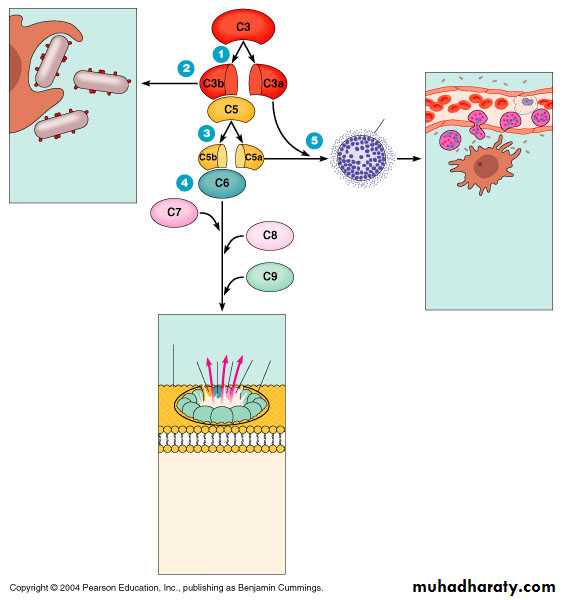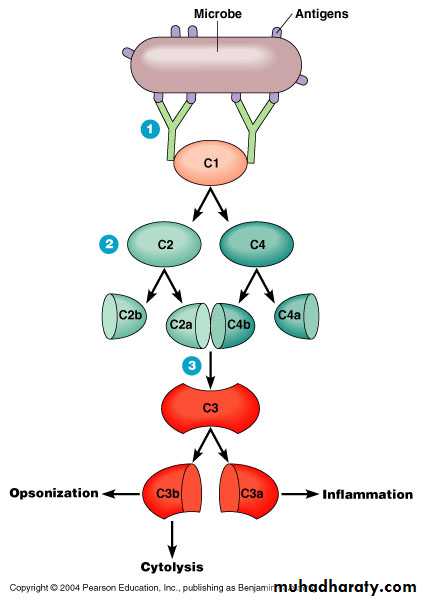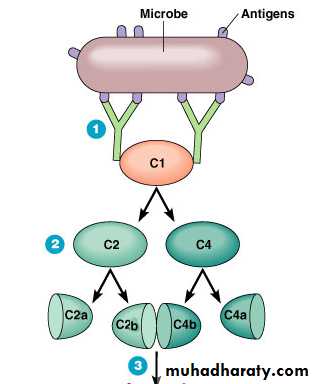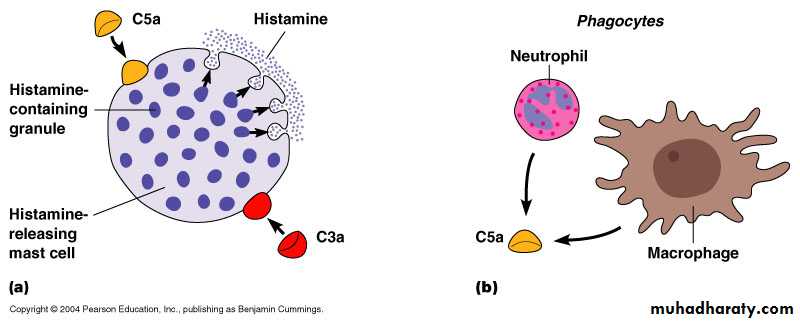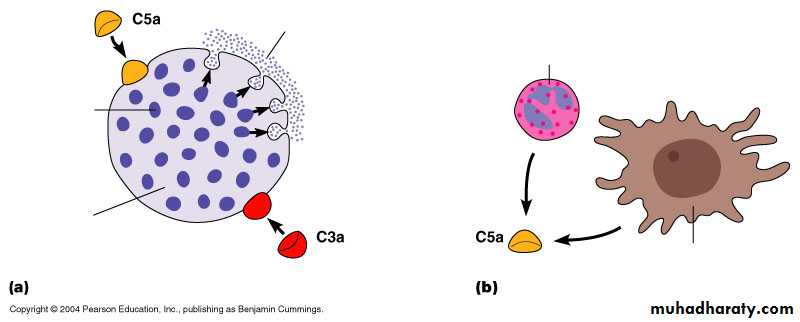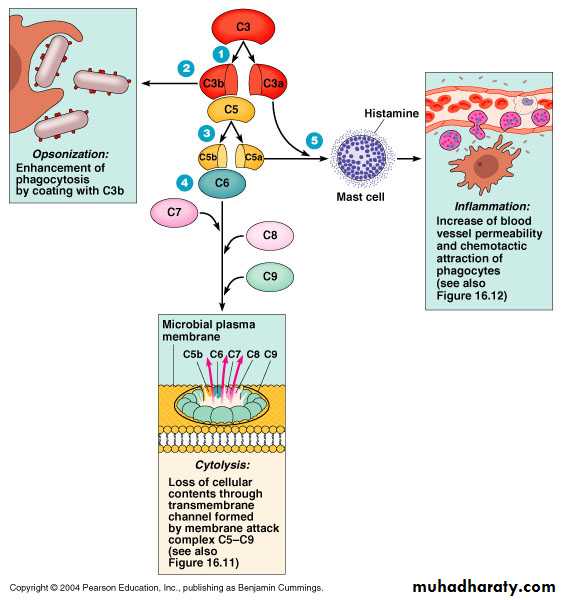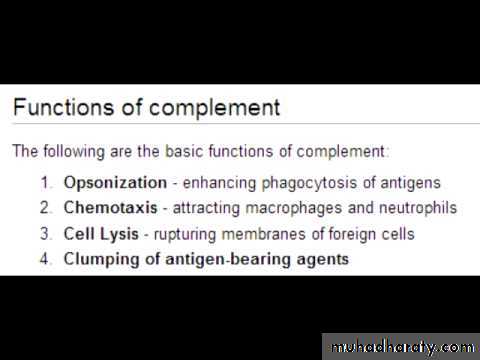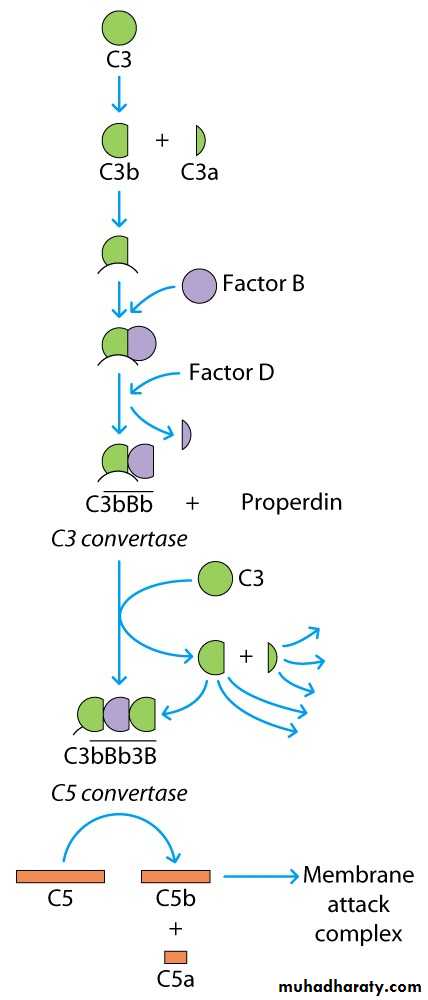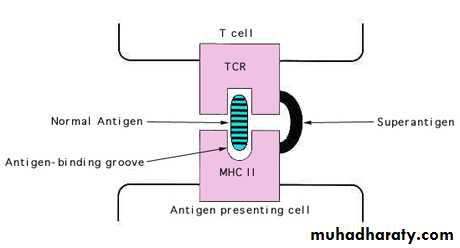The complement system
Over 20 proteins produced by the liver and found in circulating blood serum in inactive form.Once activated, the complement works as a cascade system. Cascade is when one reaction triggers another reaction which trigger others and so on. These types of systems can grow exponentially very fast.
Part of the innate immune system
The complement systemComplement system nomenclature
Complement proteins are often designated by an upper case letter C and are inactive until they are split into products.Example: C1
When the products are split, they become active. The active products are usually designated with a lower case a or b.
Example: C2a and C2b
Two Pathways
The complement system can be activated by either of two different pathways.
Classical pathway (specific immune system)
Alternative pathway (non-specific immune system)The Classical Pathway
Part of the specific immune response because it relies on antibodies to initiate it.First step C1 becomes activated when it binds to the ends of antibodies. It must attach to at least 2 Fc fragments, requires at least 2 molecules of IgG or one molecule of IgM.
C1 is called recognition unit
The building of a C3 activation complex
Once C1 is activated, it activates 2 other complement proteins, C2 and C4 by cutting them in halfC2 is cleaved into C2a and C2b
C4 is cleaved into C4a and C4bBoth C2b and C4b bind together on the surface of the bacteria
C2a and C4a diffuse away
C3 Activation complex
C2b and C4b bind together on the surface of bacteria to form a C3 activation complexThe function of the C3 activation complex is to activate C3 proteins.
This is done by cleaving C3 into C3a and C3bC3 activation complex
C3aC3a increases the inflammatory response by binding to mast cells and causing them to release histamine
C3b
The C3b bind to and coat the surface of the bacteria.
C3b is an opsonin
Opsonins are molecules that bind both to bacteria and phagocytes
Opsonization increases phagocytosis by 1,000 fold.
Bacteria
OpsoninsBuilding the C5 activation complex
Eventially enough C3b is cleaved that the surface of the bacteria begins to become saturated with it.C2b and C4b which make up the C3 activation complex has a slight affinity for C3b and C3b binds to them
When C3b binds to C2b and C4b it forms a new complex referred to as the C5 activation complex
+
C3b
=
C5 activation complex
C3 activation complex
The C5 activation complex
The C5 activation complex (C2b, C4b, C3b) activates C5 proteins by cleaving them into C5a and C5b
The function of C5a
C5a disperses away from the bacteria.
Binds to mast cells and increases inflammation.Most powerful chemotactic factor known for leukocytes
Building the Membrane Attack Complex
Many C5b proteins are produced by the C5 activation complex. These C5b begin to coat the surface of the bacteriaC5b on the surface of bacteria binds to C6
The binding of C6 to C5b activates C6 so that it can bind to C7
C7 binds to C8 which in turn binds to C9’s
Together these proteins form a circular complex called the Membrane Attack Complex (MAC)
Membrane Attack complex
The MAC causes Cytolysis.The circular membrane attack complex acts as a channel in which cytoplasm can rush out of and water rushes in.
The cell’s inner integrity is compromised and it dies
Overview
The alternative pathway
The alternative pathway is part of the non-specific defense because it does not need antibodies to initiate the pathway.The alternative pathway is slower than the classical pathway
Initiation of The Alternative pathwayC3 contains unstable thioester bond.
This unstable bond makes C3 subject to slow spontaneous hydrolysis to C3b and C3a
The C3b is able to bind to foreign surface antigens.
Mammalian cells contain sialic acid which inactivates C3b
Factor B
C3b on the surface of a foreign cells binds to another plasma protein called factor BC3bFactorB
Factor DThe binding of C3b to factor B allows a protein enzyme called Factor D to cleave Factor B to Ba and Bb.
Factor Bb remains bound to C3b while Ba and Factor D disperse away.
C3b FactorBb
unstableThe C3 activation complex
Properdin, also called factor P, binds to the C3bBb complex to stabilize it.
C3bBbP make up the C3 activation complex for the alternative pathwayThe C3 activation Complex
The C3 activation complex causes the production of more C3b.This allows the initial steps of this pathway to be repeated and amplified
2X106 molecules can be generated in 5 minutes
C3b BbP (C3 activation complex(
C3bBbPC3b(C5 activation complex(
C5 activation complex
When an additional C3b binds to the C3 activation complex it converts it into a C5 activation complex.The C5 activation complex cleaves C5 into C5a and C5b.
C5b begins the production of the MAC.
C3b BbP (C3 activation complex)
C3bBbPC3bThe Alternative complement pathway
C3b BbP (C3 activation complex)C3bBbPC3b
Superantigens
Bacterial superantigens act by binding to both the MHC protein and the TCR at positions outside the normal binding sitesuperantigens can interact with large numbers of cells, stimulating massive T-cell activation, cytokine release and systemic inflammation
. Staphylococcal enterotoxins
. Staphylococcal toxic shock toxin (TSST-1). Streptococcal pyrogenic exotoxins (exotoxin A and exotoxin B)
Hapten
Means: to fasten.
These are partial antigens (not immunogenic(.
Hapten needs carrier proteins like albumin, globulin and synthetic polypeptide to become immunogenic.
Hapten (Hp) + Carrier Protein (Cp) lead to Ab formation against hapten
Antibiotics, analgesics, penicillin and alpha-methyldopa
he complement system is a part of the immune system that enhances (complements) the ability of antibodies and phagocytic cells to clear microbes and damaged cells from an organism, promotes inflammation, and attacks the pathogen's plasma membrane. It is part of the innate immune system,[1] which is not adaptable and does not change over the course of an individual's lifetime. It can be recruited and brought into action by the adaptive immune system.

